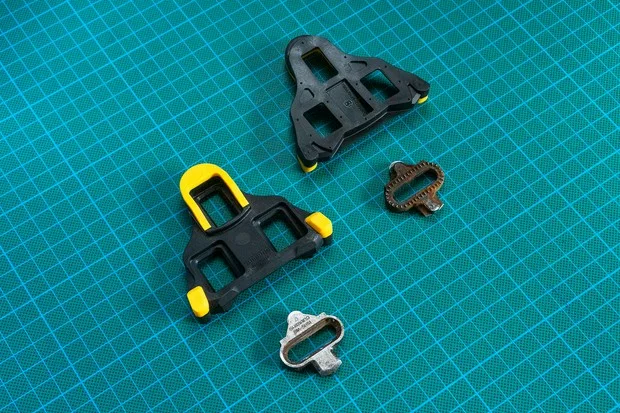Cycling shoes are an essential component of a cyclist’s kit. They provide a secure connection between the cyclist’s feet and the pedals, allowing for efficient power transfer and improved performance. One crucial aspect of cycling shoes is the type of shoe cleats used, which can affect a cyclist’s experience and performance. Two popular types of cleats are SPD and SPD-SL, and they have some key differences.
SPD cycling cleats
SPD (Shimano Pedaling Dynamics) cleats are designed for mountain biking, touring, and indoor cycling. They use a two-bolt attachment system and are typically smaller and more recessed into the sole of the shoe than SPD-SL cleats. The two-bolt attachment system is a standard found on most mountain bike pedals, and it offers a secure connection between the shoe and the pedal. They’re the smaller metal cleat in the photo above.
One advantage of SPD cleats is that they allow for easy walking. The recessed cleat design means that the cleat does not protrude significantly from the sole of the shoe, making it easier to walk around in cycling shoes. This can be especially important for mountain biking and touring, where the cyclist may need to get off the bike and walk over rough terrain. Additionally, SPD cleats are typically more comfortable for extended periods of walking or standing.
SPD-SL cycling cleats
SPD-SL cleats, on the other hand, are designed for road cycling and use a three-bolt attachment system. They are typically larger and more protruded from the sole of the shoe than SPD cleats. The three-bolt attachment system is a standard found on most road bike pedals, and it offers a more secure connection between the shoe and the pedal. These are the big almost triangular yellow-tipped plastic ones above.
One significant advantage of SPD-SL cleats is that they provide a more secure connection between the shoe and the pedal, which can improve power transfer and efficiency while cycling. The larger size of the cleat also means that it distributes the pressure over a larger area of the foot, which can reduce hotspots and improve comfort during long rides. However, the larger size and protrusion from the sole of the shoe make SPD-SL cleats less comfortable for walking than SPD cleats.
Another difference between SPD and SPD-SL cleats is their compatibility with different pedals. SPD cleats are compatible with most mountain bike pedals and some hybrid pedals, while SPD-SL cleats are compatible with most road bike pedals. It’s essential to make sure that the cleats are compatible with the pedals before purchasing, as using incompatible cleats can cause damage to the pedals and reduce performance.
Choosing either SPD or SPD-SL cleats
When choosing between SPD and SPD-SL cleats, it’s important to consider the type of cycling you do and your personal preferences. If you primarily cycle on the road, SPD-SL cleats may be a better choice because they offer a more secure connection and improved power transfer. If you cycle off-road or prefer to walk around in your cycling shoes, SPD cleats may be a better option because they allow for easy walking and are more comfortable for extended periods of standing.
In conclusion, SPD and SPD-SL cleats have some significant differences that can affect a cyclist’s experience and performance. While SPD cleats are more suitable for mountain biking, touring, and indoor cycling, SPD-SL cleats are designed for road cycling. It’s essential to consider the type of cycling you do and your personal preferences when choosing between these two types of cleats. Regardless of the type of cleat, choosing the right pair of cycling shoes is crucial for a comfortable and efficient ride.






